The World Health Organizations
VerifiedAdded on 2022/09/09
|12
|3100
|30
AI Summary
Contribute Materials
Your contribution can guide someone’s learning journey. Share your
documents today.
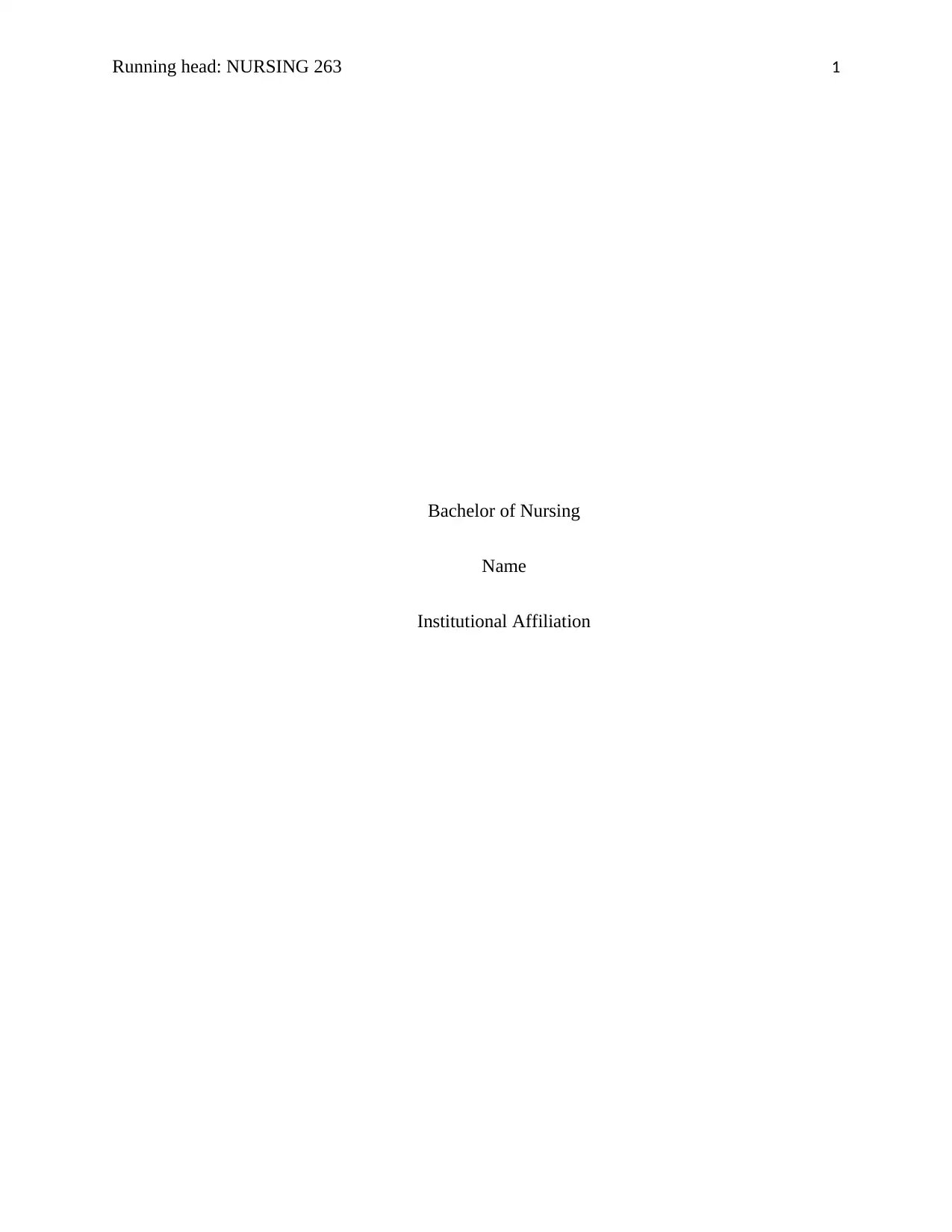
Running head: NURSING 263 1
Bachelor of Nursing
Name
Institutional Affiliation
Bachelor of Nursing
Name
Institutional Affiliation
Secure Best Marks with AI Grader
Need help grading? Try our AI Grader for instant feedback on your assignments.
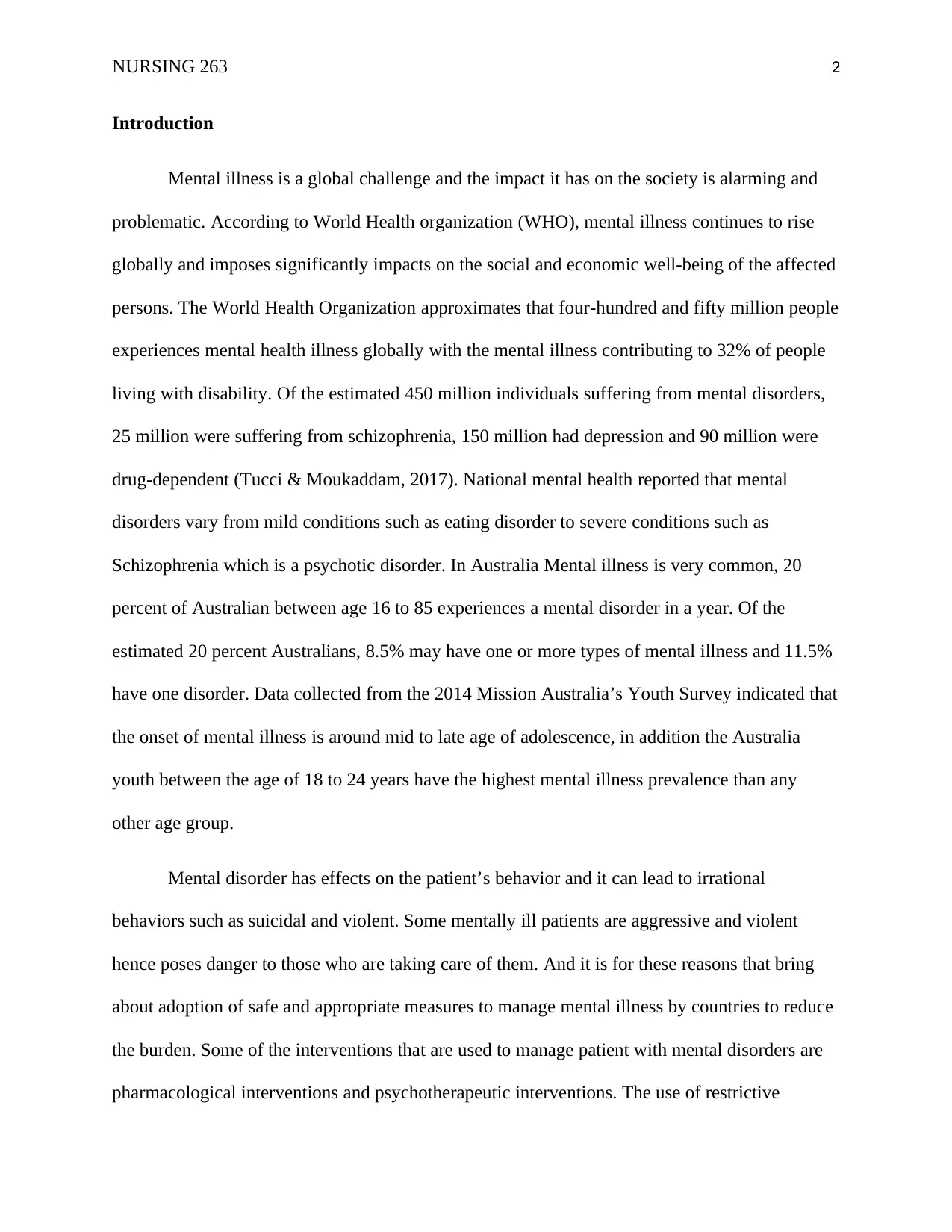
NURSING 263 2
Introduction
Mental illness is a global challenge and the impact it has on the society is alarming and
problematic. According to World Health organization (WHO), mental illness continues to rise
globally and imposes significantly impacts on the social and economic well-being of the affected
persons. The World Health Organization approximates that four-hundred and fifty million people
experiences mental health illness globally with the mental illness contributing to 32% of people
living with disability. Of the estimated 450 million individuals suffering from mental disorders,
25 million were suffering from schizophrenia, 150 million had depression and 90 million were
drug-dependent (Tucci & Moukaddam, 2017). National mental health reported that mental
disorders vary from mild conditions such as eating disorder to severe conditions such as
Schizophrenia which is a psychotic disorder. In Australia Mental illness is very common, 20
percent of Australian between age 16 to 85 experiences a mental disorder in a year. Of the
estimated 20 percent Australians, 8.5% may have one or more types of mental illness and 11.5%
have one disorder. Data collected from the 2014 Mission Australia’s Youth Survey indicated that
the onset of mental illness is around mid to late age of adolescence, in addition the Australia
youth between the age of 18 to 24 years have the highest mental illness prevalence than any
other age group.
Mental disorder has effects on the patient’s behavior and it can lead to irrational
behaviors such as suicidal and violent. Some mentally ill patients are aggressive and violent
hence poses danger to those who are taking care of them. And it is for these reasons that bring
about adoption of safe and appropriate measures to manage mental illness by countries to reduce
the burden. Some of the interventions that are used to manage patient with mental disorders are
pharmacological interventions and psychotherapeutic interventions. The use of restrictive
Introduction
Mental illness is a global challenge and the impact it has on the society is alarming and
problematic. According to World Health organization (WHO), mental illness continues to rise
globally and imposes significantly impacts on the social and economic well-being of the affected
persons. The World Health Organization approximates that four-hundred and fifty million people
experiences mental health illness globally with the mental illness contributing to 32% of people
living with disability. Of the estimated 450 million individuals suffering from mental disorders,
25 million were suffering from schizophrenia, 150 million had depression and 90 million were
drug-dependent (Tucci & Moukaddam, 2017). National mental health reported that mental
disorders vary from mild conditions such as eating disorder to severe conditions such as
Schizophrenia which is a psychotic disorder. In Australia Mental illness is very common, 20
percent of Australian between age 16 to 85 experiences a mental disorder in a year. Of the
estimated 20 percent Australians, 8.5% may have one or more types of mental illness and 11.5%
have one disorder. Data collected from the 2014 Mission Australia’s Youth Survey indicated that
the onset of mental illness is around mid to late age of adolescence, in addition the Australia
youth between the age of 18 to 24 years have the highest mental illness prevalence than any
other age group.
Mental disorder has effects on the patient’s behavior and it can lead to irrational
behaviors such as suicidal and violent. Some mentally ill patients are aggressive and violent
hence poses danger to those who are taking care of them. And it is for these reasons that bring
about adoption of safe and appropriate measures to manage mental illness by countries to reduce
the burden. Some of the interventions that are used to manage patient with mental disorders are
pharmacological interventions and psychotherapeutic interventions. The use of restrictive

NURSING 263 3
measures and coercion is also inevitable in management of mental illness. One of the major ways
that coercive measures can applied is through induction of sleep or calmness in patients with
mental illness patients by the use of sedatives. Drugs that are used to induce sleep or keep
someone calm are known as sedatives. Sedatives is an example of Psychotropics and sedatives
act via modification of the Central nervous system hence alteration of the central nerves
communication of the brain by slowing down the brain activities (Shafiekhani, Mirjalili &
Vazin, 2018). in order for the nurses to deliver these drugs safely, they use restrictive measures
for ease in application of the medication. This is because some patient might present severe
deviates behaviors such kicking and throwing punches that might may cause self-injury or injury
to the nurses. Generally, psychotropics act on the brain and the central nervous system to help
reduce violent behaviors and anxiety. Psychotic medication exists in five classes, stimulants
antipsychotic, antidepressant, mood stabilizers and anxiety agents.
The use of psychotropics to manage mental illness has a greater negative impact
compared to its advantages. Prolonged use of psychotropics medication such as sedatives can
lead to severity in the mental illness. Example of risks associated with long term use of
Psychotropics are; risks of getting amnesia, dementia, depression and suicidal thoughts.
Additionally, long term use of sedatives may lead to over dependency on the sedatives hence
interferes with the patients’ recovery among others (Clayton & Balon, 2009). Other than use of
coercive measure, a better and appropriate way that may be used in management of mental
illness is recovery-oriented mental Health support as supported by the Australian Health
Ministers’ Advisory Council (AHMAC, 2013). Negative impacts caused by restrictive measure
in mental illness has led to controversy and ongoing discussion in Australia and other countries
involved.
measures and coercion is also inevitable in management of mental illness. One of the major ways
that coercive measures can applied is through induction of sleep or calmness in patients with
mental illness patients by the use of sedatives. Drugs that are used to induce sleep or keep
someone calm are known as sedatives. Sedatives is an example of Psychotropics and sedatives
act via modification of the Central nervous system hence alteration of the central nerves
communication of the brain by slowing down the brain activities (Shafiekhani, Mirjalili &
Vazin, 2018). in order for the nurses to deliver these drugs safely, they use restrictive measures
for ease in application of the medication. This is because some patient might present severe
deviates behaviors such kicking and throwing punches that might may cause self-injury or injury
to the nurses. Generally, psychotropics act on the brain and the central nervous system to help
reduce violent behaviors and anxiety. Psychotic medication exists in five classes, stimulants
antipsychotic, antidepressant, mood stabilizers and anxiety agents.
The use of psychotropics to manage mental illness has a greater negative impact
compared to its advantages. Prolonged use of psychotropics medication such as sedatives can
lead to severity in the mental illness. Example of risks associated with long term use of
Psychotropics are; risks of getting amnesia, dementia, depression and suicidal thoughts.
Additionally, long term use of sedatives may lead to over dependency on the sedatives hence
interferes with the patients’ recovery among others (Clayton & Balon, 2009). Other than use of
coercive measure, a better and appropriate way that may be used in management of mental
illness is recovery-oriented mental Health support as supported by the Australian Health
Ministers’ Advisory Council (AHMAC, 2013). Negative impacts caused by restrictive measure
in mental illness has led to controversy and ongoing discussion in Australia and other countries
involved.
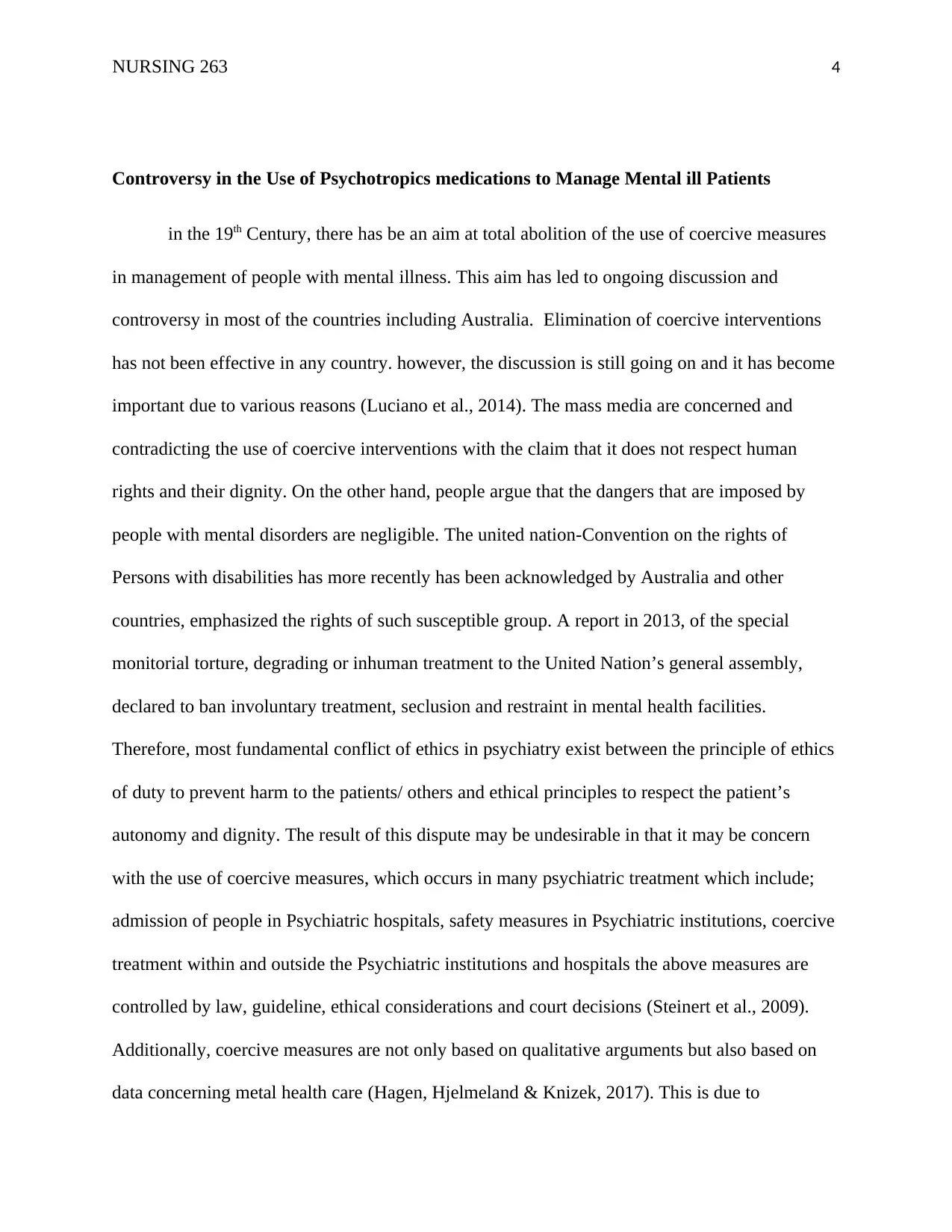
NURSING 263 4
Controversy in the Use of Psychotropics medications to Manage Mental ill Patients
in the 19th Century, there has be an aim at total abolition of the use of coercive measures
in management of people with mental illness. This aim has led to ongoing discussion and
controversy in most of the countries including Australia. Elimination of coercive interventions
has not been effective in any country. however, the discussion is still going on and it has become
important due to various reasons (Luciano et al., 2014). The mass media are concerned and
contradicting the use of coercive interventions with the claim that it does not respect human
rights and their dignity. On the other hand, people argue that the dangers that are imposed by
people with mental disorders are negligible. The united nation-Convention on the rights of
Persons with disabilities has more recently has been acknowledged by Australia and other
countries, emphasized the rights of such susceptible group. A report in 2013, of the special
monitorial torture, degrading or inhuman treatment to the United Nation’s general assembly,
declared to ban involuntary treatment, seclusion and restraint in mental health facilities.
Therefore, most fundamental conflict of ethics in psychiatry exist between the principle of ethics
of duty to prevent harm to the patients/ others and ethical principles to respect the patient’s
autonomy and dignity. The result of this dispute may be undesirable in that it may be concern
with the use of coercive measures, which occurs in many psychiatric treatment which include;
admission of people in Psychiatric hospitals, safety measures in Psychiatric institutions, coercive
treatment within and outside the Psychiatric institutions and hospitals the above measures are
controlled by law, guideline, ethical considerations and court decisions (Steinert et al., 2009).
Additionally, coercive measures are not only based on qualitative arguments but also based on
data concerning metal health care (Hagen, Hjelmeland & Knizek, 2017). This is due to
Controversy in the Use of Psychotropics medications to Manage Mental ill Patients
in the 19th Century, there has be an aim at total abolition of the use of coercive measures
in management of people with mental illness. This aim has led to ongoing discussion and
controversy in most of the countries including Australia. Elimination of coercive interventions
has not been effective in any country. however, the discussion is still going on and it has become
important due to various reasons (Luciano et al., 2014). The mass media are concerned and
contradicting the use of coercive interventions with the claim that it does not respect human
rights and their dignity. On the other hand, people argue that the dangers that are imposed by
people with mental disorders are negligible. The united nation-Convention on the rights of
Persons with disabilities has more recently has been acknowledged by Australia and other
countries, emphasized the rights of such susceptible group. A report in 2013, of the special
monitorial torture, degrading or inhuman treatment to the United Nation’s general assembly,
declared to ban involuntary treatment, seclusion and restraint in mental health facilities.
Therefore, most fundamental conflict of ethics in psychiatry exist between the principle of ethics
of duty to prevent harm to the patients/ others and ethical principles to respect the patient’s
autonomy and dignity. The result of this dispute may be undesirable in that it may be concern
with the use of coercive measures, which occurs in many psychiatric treatment which include;
admission of people in Psychiatric hospitals, safety measures in Psychiatric institutions, coercive
treatment within and outside the Psychiatric institutions and hospitals the above measures are
controlled by law, guideline, ethical considerations and court decisions (Steinert et al., 2009).
Additionally, coercive measures are not only based on qualitative arguments but also based on
data concerning metal health care (Hagen, Hjelmeland & Knizek, 2017). This is due to
Secure Best Marks with AI Grader
Need help grading? Try our AI Grader for instant feedback on your assignments.
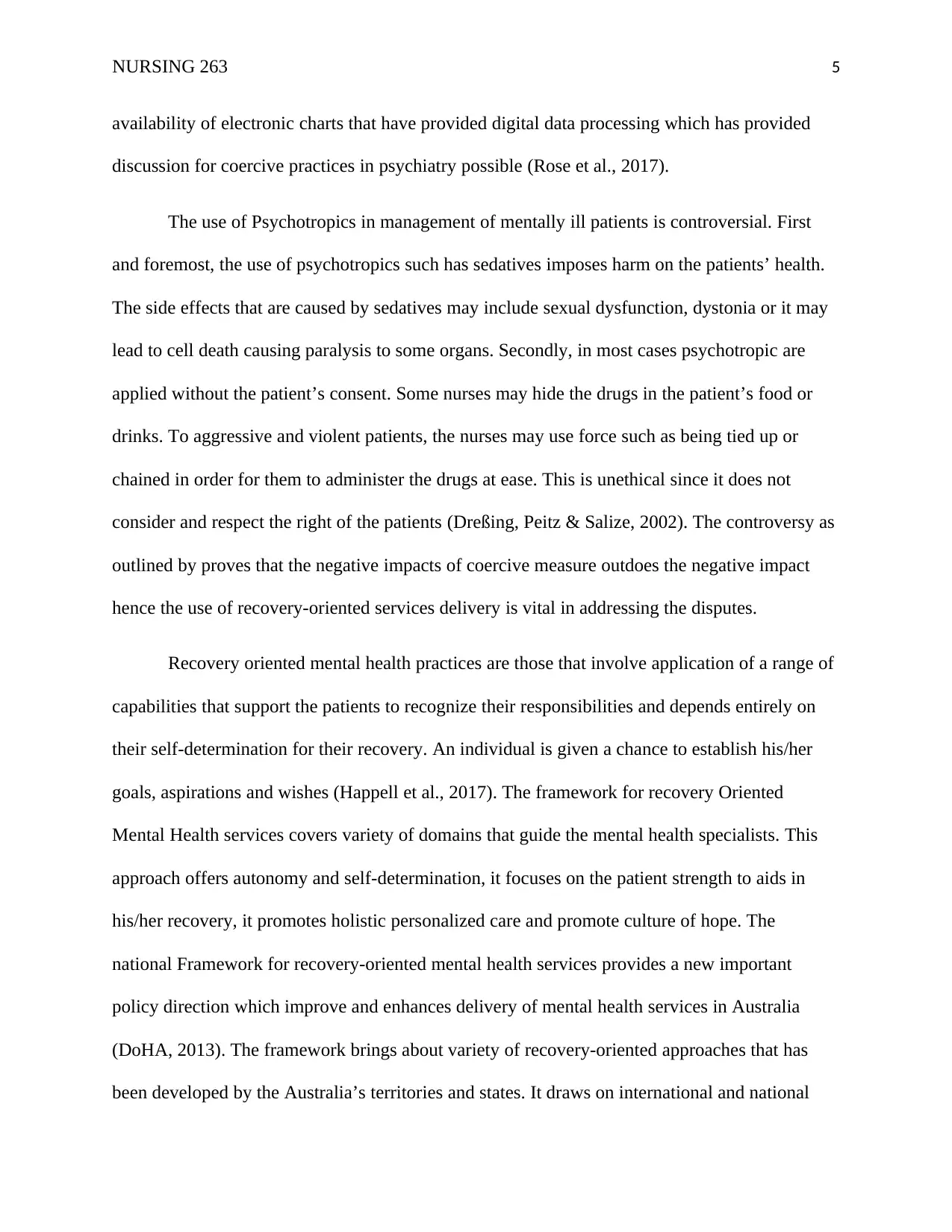
NURSING 263 5
availability of electronic charts that have provided digital data processing which has provided
discussion for coercive practices in psychiatry possible (Rose et al., 2017).
The use of Psychotropics in management of mentally ill patients is controversial. First
and foremost, the use of psychotropics such has sedatives imposes harm on the patients’ health.
The side effects that are caused by sedatives may include sexual dysfunction, dystonia or it may
lead to cell death causing paralysis to some organs. Secondly, in most cases psychotropic are
applied without the patient’s consent. Some nurses may hide the drugs in the patient’s food or
drinks. To aggressive and violent patients, the nurses may use force such as being tied up or
chained in order for them to administer the drugs at ease. This is unethical since it does not
consider and respect the right of the patients (Dreßing, Peitz & Salize, 2002). The controversy as
outlined by proves that the negative impacts of coercive measure outdoes the negative impact
hence the use of recovery-oriented services delivery is vital in addressing the disputes.
Recovery oriented mental health practices are those that involve application of a range of
capabilities that support the patients to recognize their responsibilities and depends entirely on
their self-determination for their recovery. An individual is given a chance to establish his/her
goals, aspirations and wishes (Happell et al., 2017). The framework for recovery Oriented
Mental Health services covers variety of domains that guide the mental health specialists. This
approach offers autonomy and self-determination, it focuses on the patient strength to aids in
his/her recovery, it promotes holistic personalized care and promote culture of hope. The
national Framework for recovery-oriented mental health services provides a new important
policy direction which improve and enhances delivery of mental health services in Australia
(DoHA, 2013). The framework brings about variety of recovery-oriented approaches that has
been developed by the Australia’s territories and states. It draws on international and national
availability of electronic charts that have provided digital data processing which has provided
discussion for coercive practices in psychiatry possible (Rose et al., 2017).
The use of Psychotropics in management of mentally ill patients is controversial. First
and foremost, the use of psychotropics such has sedatives imposes harm on the patients’ health.
The side effects that are caused by sedatives may include sexual dysfunction, dystonia or it may
lead to cell death causing paralysis to some organs. Secondly, in most cases psychotropic are
applied without the patient’s consent. Some nurses may hide the drugs in the patient’s food or
drinks. To aggressive and violent patients, the nurses may use force such as being tied up or
chained in order for them to administer the drugs at ease. This is unethical since it does not
consider and respect the right of the patients (Dreßing, Peitz & Salize, 2002). The controversy as
outlined by proves that the negative impacts of coercive measure outdoes the negative impact
hence the use of recovery-oriented services delivery is vital in addressing the disputes.
Recovery oriented mental health practices are those that involve application of a range of
capabilities that support the patients to recognize their responsibilities and depends entirely on
their self-determination for their recovery. An individual is given a chance to establish his/her
goals, aspirations and wishes (Happell et al., 2017). The framework for recovery Oriented
Mental Health services covers variety of domains that guide the mental health specialists. This
approach offers autonomy and self-determination, it focuses on the patient strength to aids in
his/her recovery, it promotes holistic personalized care and promote culture of hope. The
national Framework for recovery-oriented mental health services provides a new important
policy direction which improve and enhances delivery of mental health services in Australia
(DoHA, 2013). The framework brings about variety of recovery-oriented approaches that has
been developed by the Australia’s territories and states. It draws on international and national
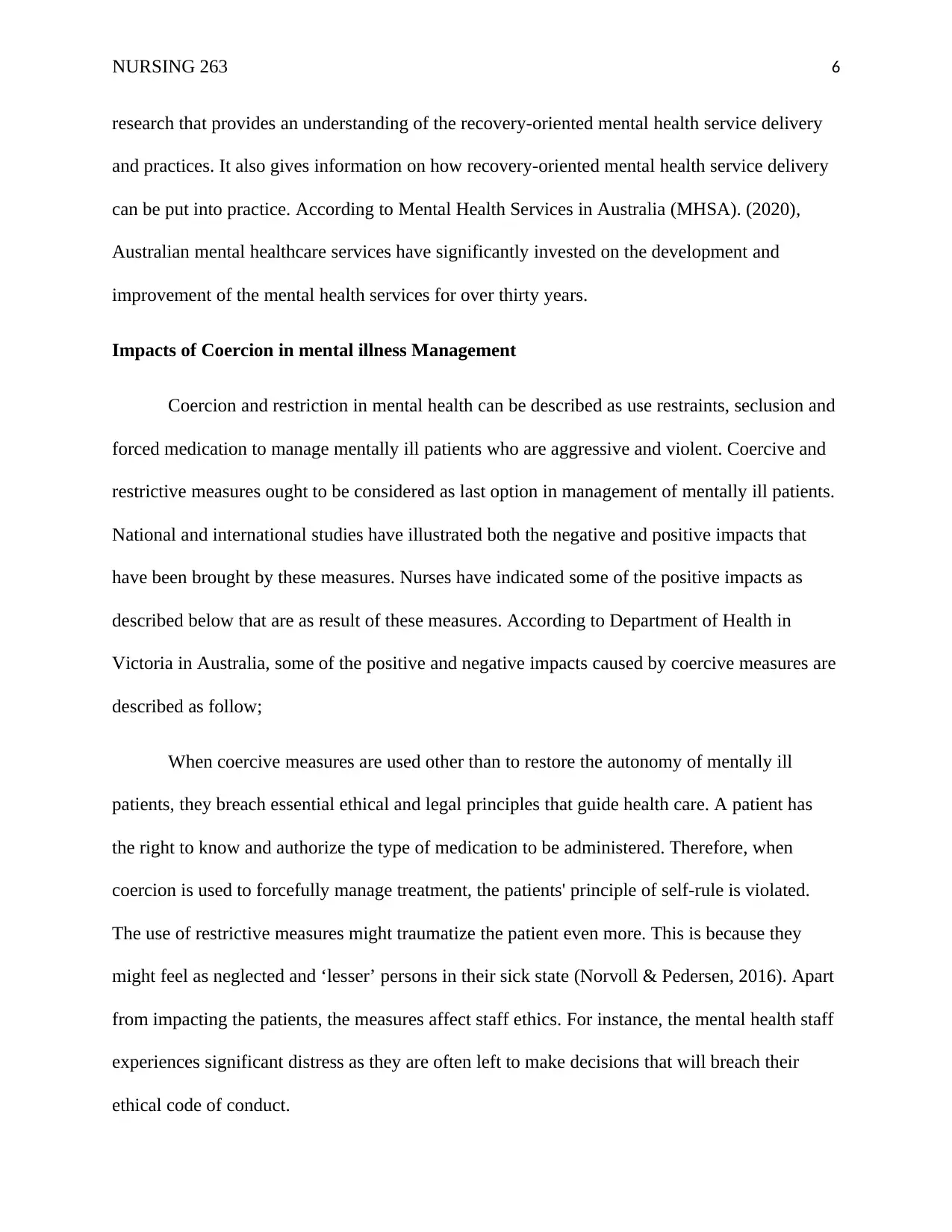
NURSING 263 6
research that provides an understanding of the recovery-oriented mental health service delivery
and practices. It also gives information on how recovery-oriented mental health service delivery
can be put into practice. According to Mental Health Services in Australia (MHSA). (2020),
Australian mental healthcare services have significantly invested on the development and
improvement of the mental health services for over thirty years.
Impacts of Coercion in mental illness Management
Coercion and restriction in mental health can be described as use restraints, seclusion and
forced medication to manage mentally ill patients who are aggressive and violent. Coercive and
restrictive measures ought to be considered as last option in management of mentally ill patients.
National and international studies have illustrated both the negative and positive impacts that
have been brought by these measures. Nurses have indicated some of the positive impacts as
described below that are as result of these measures. According to Department of Health in
Victoria in Australia, some of the positive and negative impacts caused by coercive measures are
described as follow;
When coercive measures are used other than to restore the autonomy of mentally ill
patients, they breach essential ethical and legal principles that guide health care. A patient has
the right to know and authorize the type of medication to be administered. Therefore, when
coercion is used to forcefully manage treatment, the patients' principle of self-rule is violated.
The use of restrictive measures might traumatize the patient even more. This is because they
might feel as neglected and ‘lesser’ persons in their sick state (Norvoll & Pedersen, 2016). Apart
from impacting the patients, the measures affect staff ethics. For instance, the mental health staff
experiences significant distress as they are often left to make decisions that will breach their
ethical code of conduct.
research that provides an understanding of the recovery-oriented mental health service delivery
and practices. It also gives information on how recovery-oriented mental health service delivery
can be put into practice. According to Mental Health Services in Australia (MHSA). (2020),
Australian mental healthcare services have significantly invested on the development and
improvement of the mental health services for over thirty years.
Impacts of Coercion in mental illness Management
Coercion and restriction in mental health can be described as use restraints, seclusion and
forced medication to manage mentally ill patients who are aggressive and violent. Coercive and
restrictive measures ought to be considered as last option in management of mentally ill patients.
National and international studies have illustrated both the negative and positive impacts that
have been brought by these measures. Nurses have indicated some of the positive impacts as
described below that are as result of these measures. According to Department of Health in
Victoria in Australia, some of the positive and negative impacts caused by coercive measures are
described as follow;
When coercive measures are used other than to restore the autonomy of mentally ill
patients, they breach essential ethical and legal principles that guide health care. A patient has
the right to know and authorize the type of medication to be administered. Therefore, when
coercion is used to forcefully manage treatment, the patients' principle of self-rule is violated.
The use of restrictive measures might traumatize the patient even more. This is because they
might feel as neglected and ‘lesser’ persons in their sick state (Norvoll & Pedersen, 2016). Apart
from impacting the patients, the measures affect staff ethics. For instance, the mental health staff
experiences significant distress as they are often left to make decisions that will breach their
ethical code of conduct.
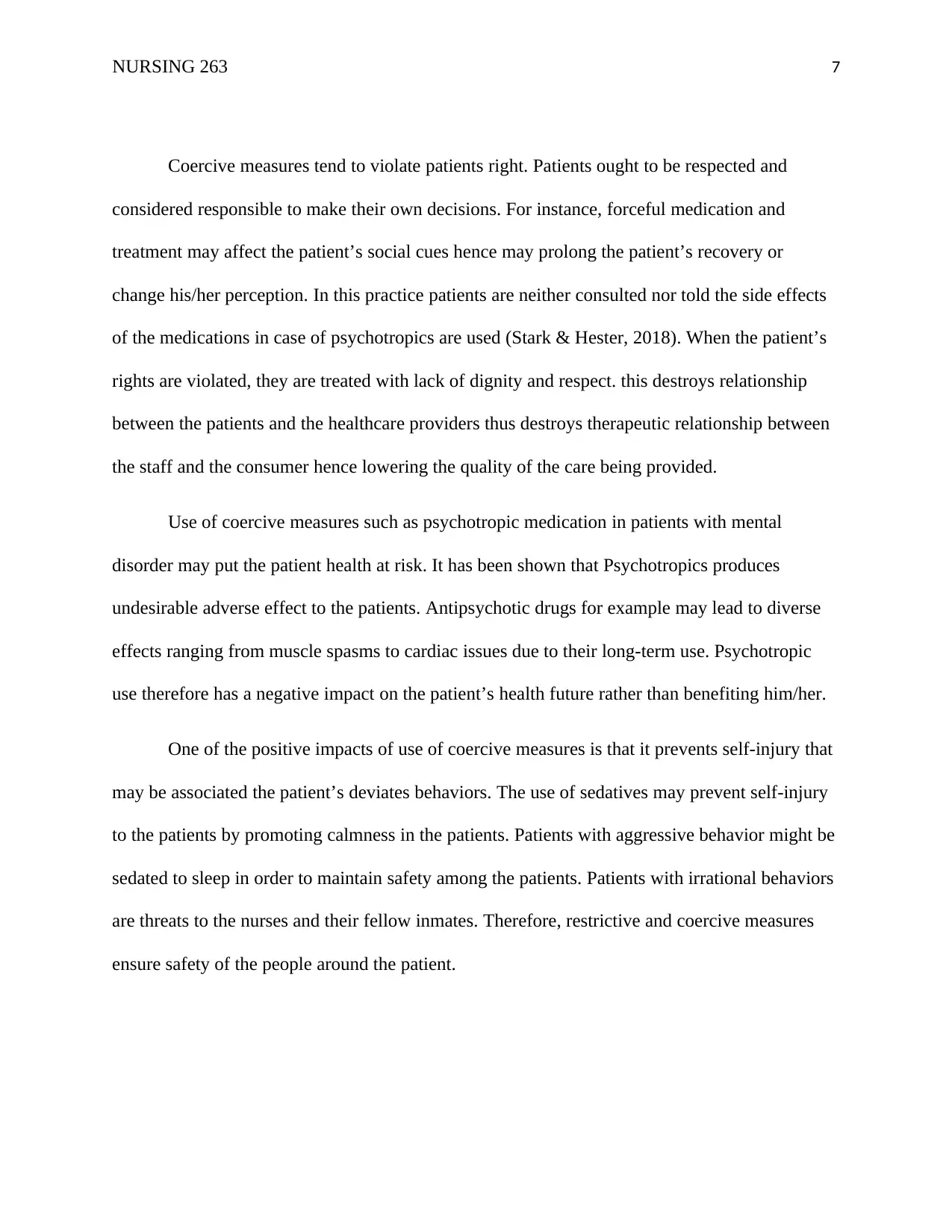
NURSING 263 7
Coercive measures tend to violate patients right. Patients ought to be respected and
considered responsible to make their own decisions. For instance, forceful medication and
treatment may affect the patient’s social cues hence may prolong the patient’s recovery or
change his/her perception. In this practice patients are neither consulted nor told the side effects
of the medications in case of psychotropics are used (Stark & Hester, 2018). When the patient’s
rights are violated, they are treated with lack of dignity and respect. this destroys relationship
between the patients and the healthcare providers thus destroys therapeutic relationship between
the staff and the consumer hence lowering the quality of the care being provided.
Use of coercive measures such as psychotropic medication in patients with mental
disorder may put the patient health at risk. It has been shown that Psychotropics produces
undesirable adverse effect to the patients. Antipsychotic drugs for example may lead to diverse
effects ranging from muscle spasms to cardiac issues due to their long-term use. Psychotropic
use therefore has a negative impact on the patient’s health future rather than benefiting him/her.
One of the positive impacts of use of coercive measures is that it prevents self-injury that
may be associated the patient’s deviates behaviors. The use of sedatives may prevent self-injury
to the patients by promoting calmness in the patients. Patients with aggressive behavior might be
sedated to sleep in order to maintain safety among the patients. Patients with irrational behaviors
are threats to the nurses and their fellow inmates. Therefore, restrictive and coercive measures
ensure safety of the people around the patient.
Coercive measures tend to violate patients right. Patients ought to be respected and
considered responsible to make their own decisions. For instance, forceful medication and
treatment may affect the patient’s social cues hence may prolong the patient’s recovery or
change his/her perception. In this practice patients are neither consulted nor told the side effects
of the medications in case of psychotropics are used (Stark & Hester, 2018). When the patient’s
rights are violated, they are treated with lack of dignity and respect. this destroys relationship
between the patients and the healthcare providers thus destroys therapeutic relationship between
the staff and the consumer hence lowering the quality of the care being provided.
Use of coercive measures such as psychotropic medication in patients with mental
disorder may put the patient health at risk. It has been shown that Psychotropics produces
undesirable adverse effect to the patients. Antipsychotic drugs for example may lead to diverse
effects ranging from muscle spasms to cardiac issues due to their long-term use. Psychotropic
use therefore has a negative impact on the patient’s health future rather than benefiting him/her.
One of the positive impacts of use of coercive measures is that it prevents self-injury that
may be associated the patient’s deviates behaviors. The use of sedatives may prevent self-injury
to the patients by promoting calmness in the patients. Patients with aggressive behavior might be
sedated to sleep in order to maintain safety among the patients. Patients with irrational behaviors
are threats to the nurses and their fellow inmates. Therefore, restrictive and coercive measures
ensure safety of the people around the patient.
Paraphrase This Document
Need a fresh take? Get an instant paraphrase of this document with our AI Paraphraser
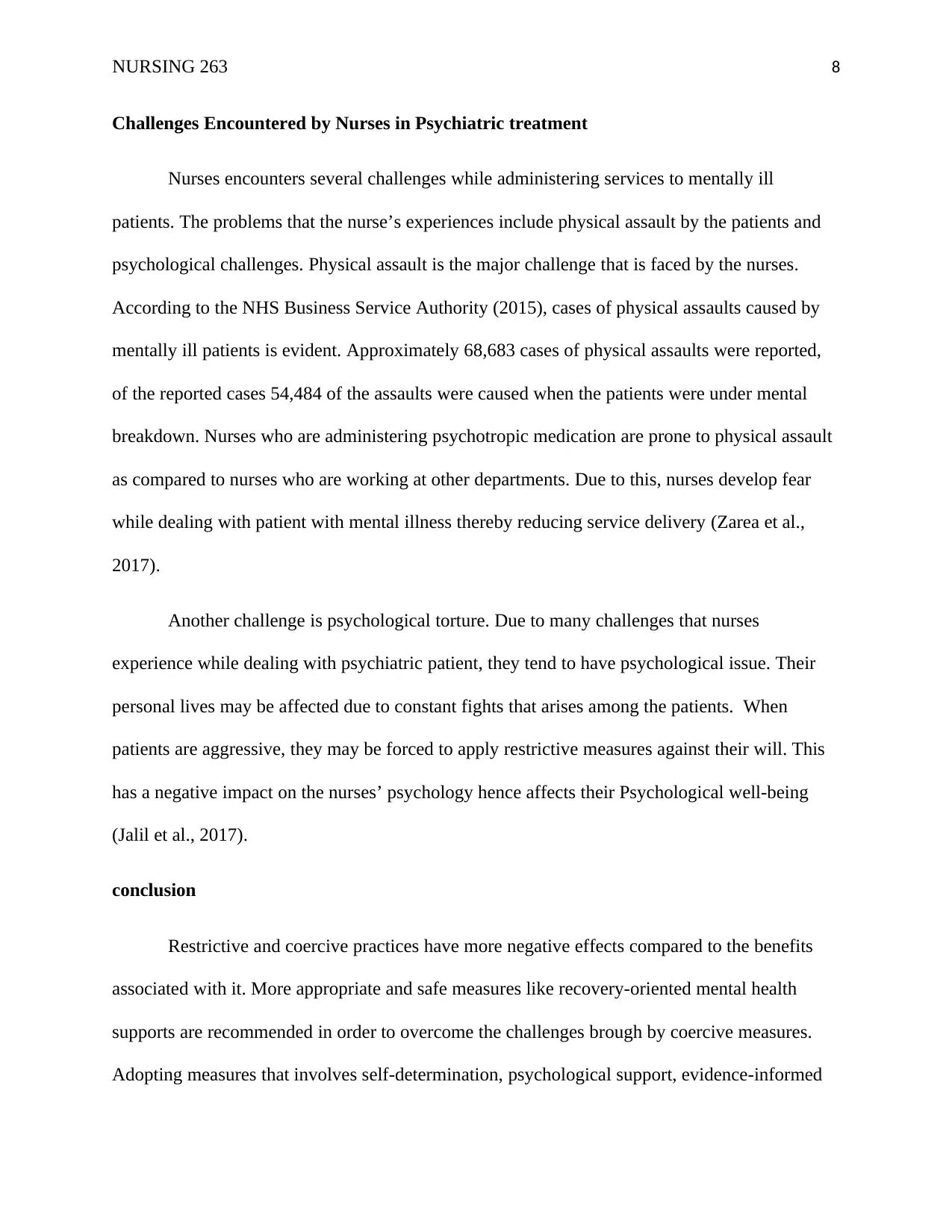
NURSING 263 8
Challenges Encountered by Nurses in Psychiatric treatment
Nurses encounters several challenges while administering services to mentally ill
patients. The problems that the nurse’s experiences include physical assault by the patients and
psychological challenges. Physical assault is the major challenge that is faced by the nurses.
According to the NHS Business Service Authority (2015), cases of physical assaults caused by
mentally ill patients is evident. Approximately 68,683 cases of physical assaults were reported,
of the reported cases 54,484 of the assaults were caused when the patients were under mental
breakdown. Nurses who are administering psychotropic medication are prone to physical assault
as compared to nurses who are working at other departments. Due to this, nurses develop fear
while dealing with patient with mental illness thereby reducing service delivery (Zarea et al.,
2017).
Another challenge is psychological torture. Due to many challenges that nurses
experience while dealing with psychiatric patient, they tend to have psychological issue. Their
personal lives may be affected due to constant fights that arises among the patients. When
patients are aggressive, they may be forced to apply restrictive measures against their will. This
has a negative impact on the nurses’ psychology hence affects their Psychological well-being
(Jalil et al., 2017).
conclusion
Restrictive and coercive practices have more negative effects compared to the benefits
associated with it. More appropriate and safe measures like recovery-oriented mental health
supports are recommended in order to overcome the challenges brough by coercive measures.
Adopting measures that involves self-determination, psychological support, evidence-informed
Challenges Encountered by Nurses in Psychiatric treatment
Nurses encounters several challenges while administering services to mentally ill
patients. The problems that the nurse’s experiences include physical assault by the patients and
psychological challenges. Physical assault is the major challenge that is faced by the nurses.
According to the NHS Business Service Authority (2015), cases of physical assaults caused by
mentally ill patients is evident. Approximately 68,683 cases of physical assaults were reported,
of the reported cases 54,484 of the assaults were caused when the patients were under mental
breakdown. Nurses who are administering psychotropic medication are prone to physical assault
as compared to nurses who are working at other departments. Due to this, nurses develop fear
while dealing with patient with mental illness thereby reducing service delivery (Zarea et al.,
2017).
Another challenge is psychological torture. Due to many challenges that nurses
experience while dealing with psychiatric patient, they tend to have psychological issue. Their
personal lives may be affected due to constant fights that arises among the patients. When
patients are aggressive, they may be forced to apply restrictive measures against their will. This
has a negative impact on the nurses’ psychology hence affects their Psychological well-being
(Jalil et al., 2017).
conclusion
Restrictive and coercive practices have more negative effects compared to the benefits
associated with it. More appropriate and safe measures like recovery-oriented mental health
supports are recommended in order to overcome the challenges brough by coercive measures.
Adopting measures that involves self-determination, psychological support, evidence-informed
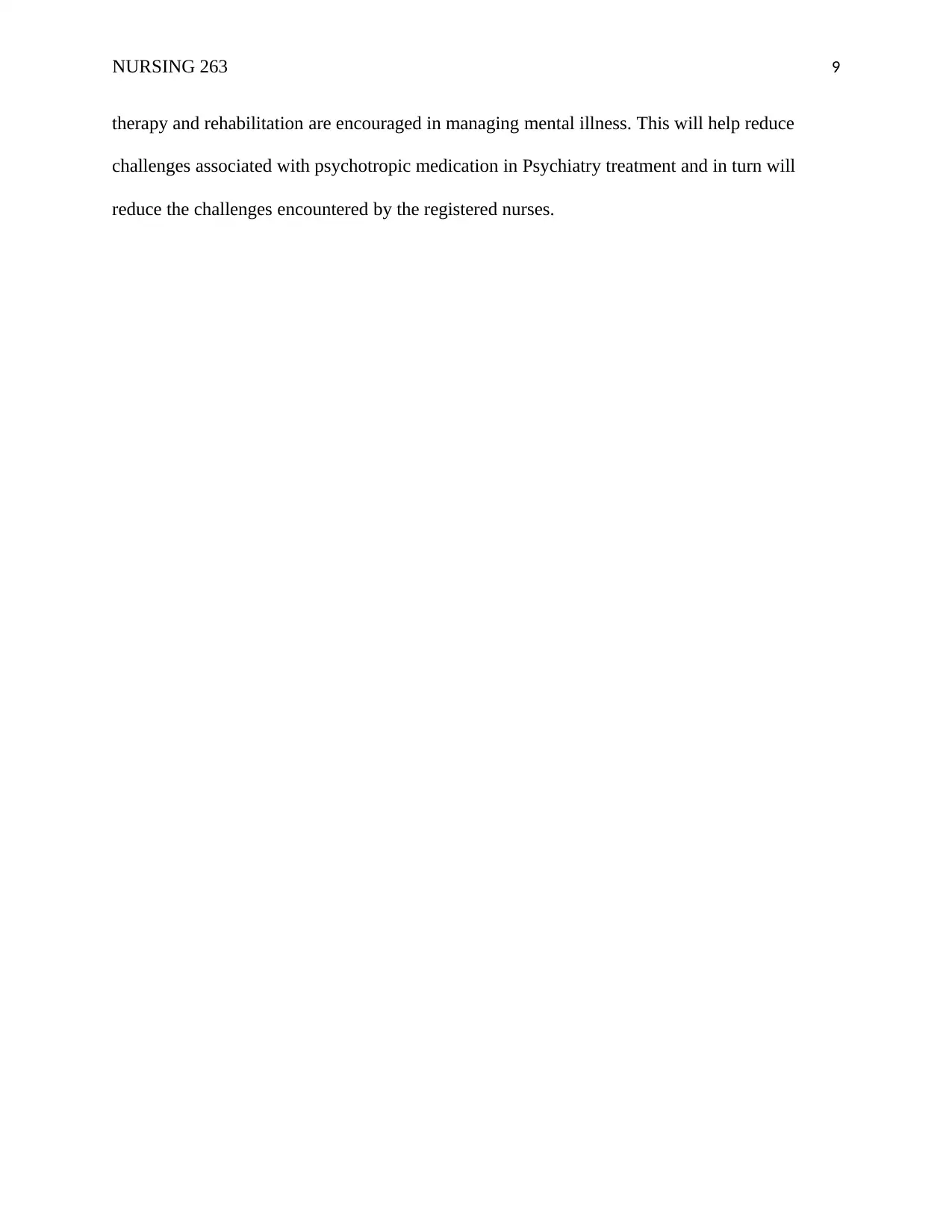
NURSING 263 9
therapy and rehabilitation are encouraged in managing mental illness. This will help reduce
challenges associated with psychotropic medication in Psychiatry treatment and in turn will
reduce the challenges encountered by the registered nurses.
therapy and rehabilitation are encouraged in managing mental illness. This will help reduce
challenges associated with psychotropic medication in Psychiatry treatment and in turn will
reduce the challenges encountered by the registered nurses.
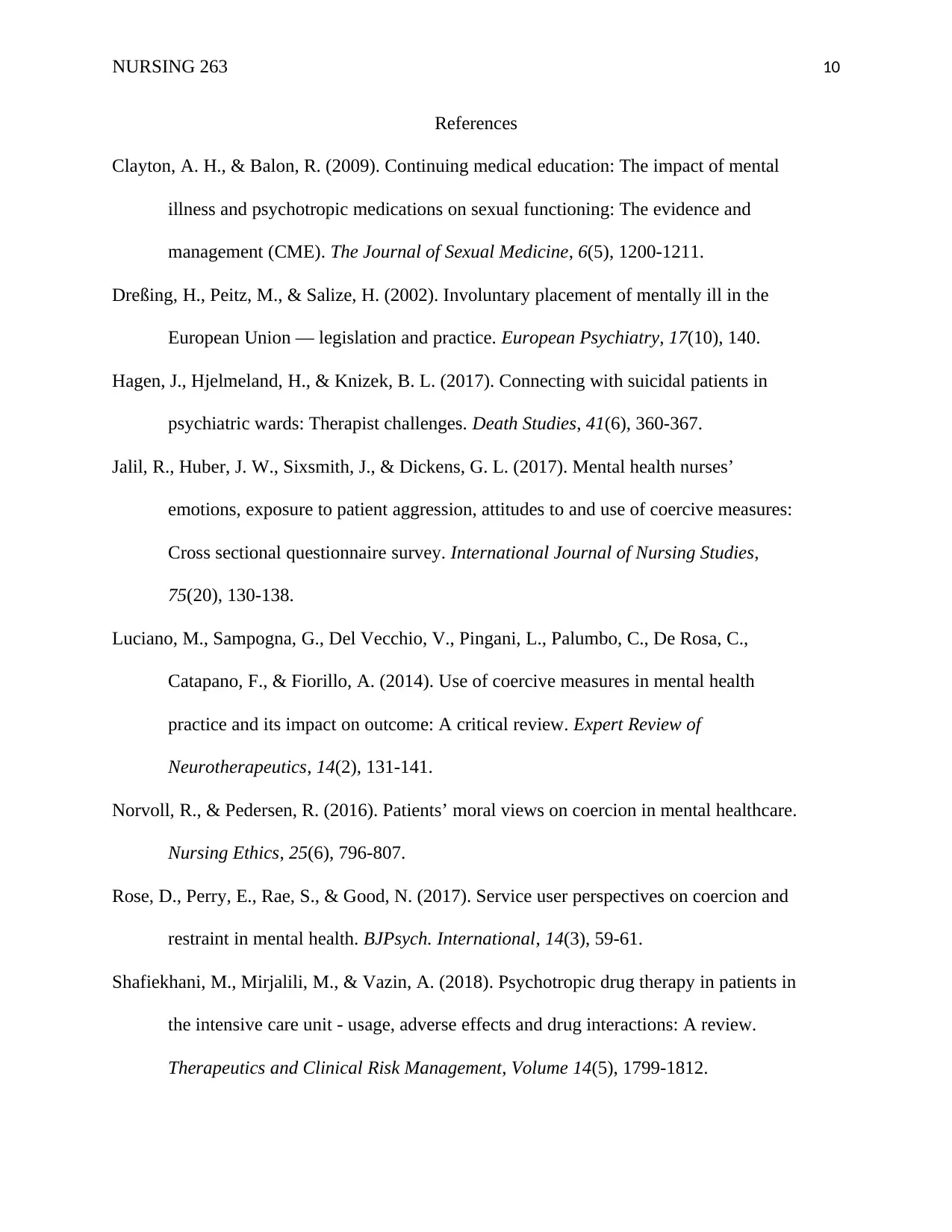
NURSING 263 10
References
Clayton, A. H., & Balon, R. (2009). Continuing medical education: The impact of mental
illness and psychotropic medications on sexual functioning: The evidence and
management (CME). The Journal of Sexual Medicine, 6(5), 1200-1211.
Dreßing, H., Peitz, M., & Salize, H. (2002). Involuntary placement of mentally ill in the
European Union — legislation and practice. European Psychiatry, 17(10), 140.
Hagen, J., Hjelmeland, H., & Knizek, B. L. (2017). Connecting with suicidal patients in
psychiatric wards: Therapist challenges. Death Studies, 41(6), 360-367.
Jalil, R., Huber, J. W., Sixsmith, J., & Dickens, G. L. (2017). Mental health nurses’
emotions, exposure to patient aggression, attitudes to and use of coercive measures:
Cross sectional questionnaire survey. International Journal of Nursing Studies,
75(20), 130-138.
Luciano, M., Sampogna, G., Del Vecchio, V., Pingani, L., Palumbo, C., De Rosa, C.,
Catapano, F., & Fiorillo, A. (2014). Use of coercive measures in mental health
practice and its impact on outcome: A critical review. Expert Review of
Neurotherapeutics, 14(2), 131-141.
Norvoll, R., & Pedersen, R. (2016). Patients’ moral views on coercion in mental healthcare.
Nursing Ethics, 25(6), 796-807.
Rose, D., Perry, E., Rae, S., & Good, N. (2017). Service user perspectives on coercion and
restraint in mental health. BJPsych. International, 14(3), 59-61.
Shafiekhani, M., Mirjalili, M., & Vazin, A. (2018). Psychotropic drug therapy in patients in
the intensive care unit - usage, adverse effects and drug interactions: A review.
Therapeutics and Clinical Risk Management, Volume 14(5), 1799-1812.
References
Clayton, A. H., & Balon, R. (2009). Continuing medical education: The impact of mental
illness and psychotropic medications on sexual functioning: The evidence and
management (CME). The Journal of Sexual Medicine, 6(5), 1200-1211.
Dreßing, H., Peitz, M., & Salize, H. (2002). Involuntary placement of mentally ill in the
European Union — legislation and practice. European Psychiatry, 17(10), 140.
Hagen, J., Hjelmeland, H., & Knizek, B. L. (2017). Connecting with suicidal patients in
psychiatric wards: Therapist challenges. Death Studies, 41(6), 360-367.
Jalil, R., Huber, J. W., Sixsmith, J., & Dickens, G. L. (2017). Mental health nurses’
emotions, exposure to patient aggression, attitudes to and use of coercive measures:
Cross sectional questionnaire survey. International Journal of Nursing Studies,
75(20), 130-138.
Luciano, M., Sampogna, G., Del Vecchio, V., Pingani, L., Palumbo, C., De Rosa, C.,
Catapano, F., & Fiorillo, A. (2014). Use of coercive measures in mental health
practice and its impact on outcome: A critical review. Expert Review of
Neurotherapeutics, 14(2), 131-141.
Norvoll, R., & Pedersen, R. (2016). Patients’ moral views on coercion in mental healthcare.
Nursing Ethics, 25(6), 796-807.
Rose, D., Perry, E., Rae, S., & Good, N. (2017). Service user perspectives on coercion and
restraint in mental health. BJPsych. International, 14(3), 59-61.
Shafiekhani, M., Mirjalili, M., & Vazin, A. (2018). Psychotropic drug therapy in patients in
the intensive care unit - usage, adverse effects and drug interactions: A review.
Therapeutics and Clinical Risk Management, Volume 14(5), 1799-1812.
Secure Best Marks with AI Grader
Need help grading? Try our AI Grader for instant feedback on your assignments.
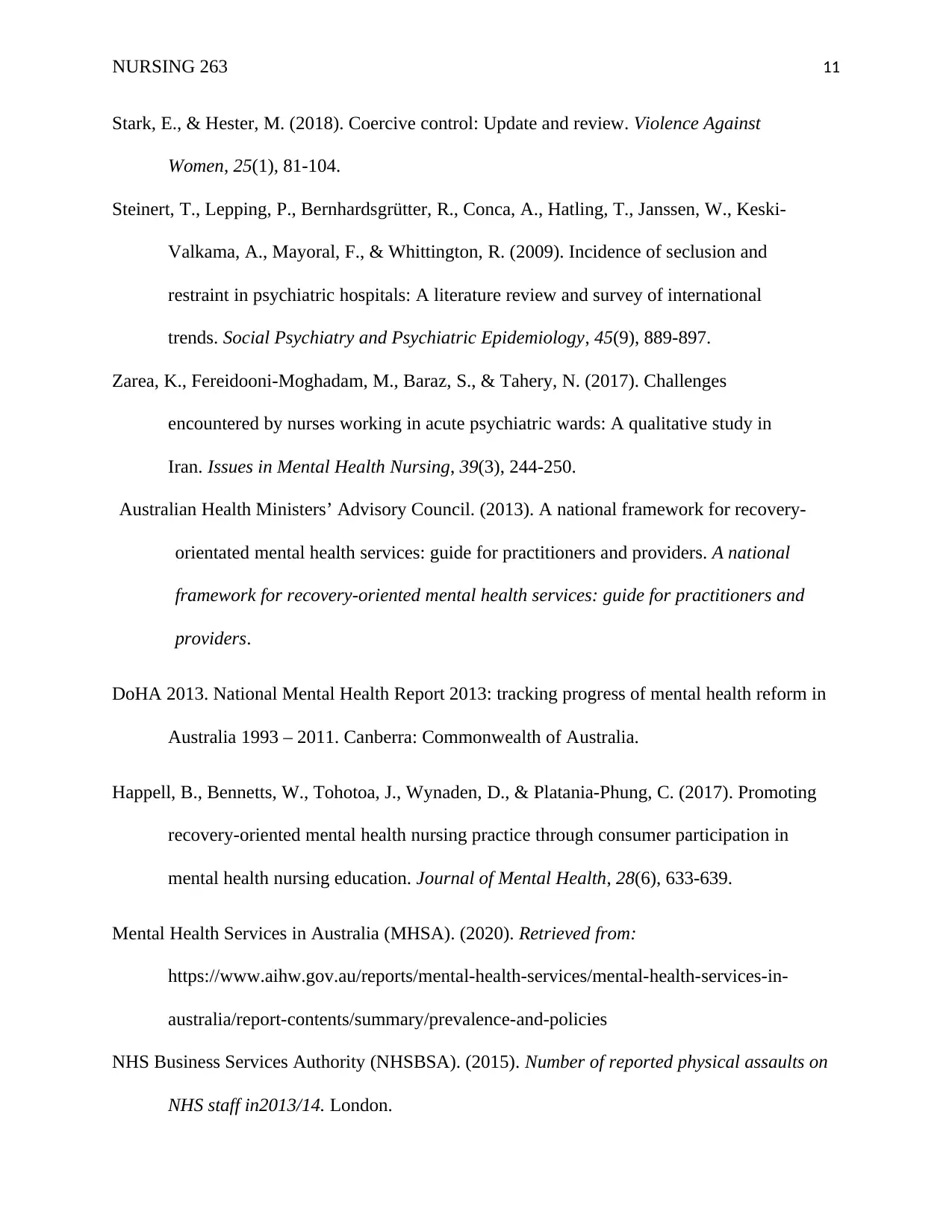
NURSING 263 11
Stark, E., & Hester, M. (2018). Coercive control: Update and review. Violence Against
Women, 25(1), 81-104.
Steinert, T., Lepping, P., Bernhardsgrütter, R., Conca, A., Hatling, T., Janssen, W., Keski-
Valkama, A., Mayoral, F., & Whittington, R. (2009). Incidence of seclusion and
restraint in psychiatric hospitals: A literature review and survey of international
trends. Social Psychiatry and Psychiatric Epidemiology, 45(9), 889-897.
Zarea, K., Fereidooni-Moghadam, M., Baraz, S., & Tahery, N. (2017). Challenges
encountered by nurses working in acute psychiatric wards: A qualitative study in
Iran. Issues in Mental Health Nursing, 39(3), 244-250.
Australian Health Ministers’ Advisory Council. (2013). A national framework for recovery-
orientated mental health services: guide for practitioners and providers. A national
framework for recovery-oriented mental health services: guide for practitioners and
providers.
DoHA 2013. National Mental Health Report 2013: tracking progress of mental health reform in
Australia 1993 – 2011. Canberra: Commonwealth of Australia.
Happell, B., Bennetts, W., Tohotoa, J., Wynaden, D., & Platania-Phung, C. (2017). Promoting
recovery-oriented mental health nursing practice through consumer participation in
mental health nursing education. Journal of Mental Health, 28(6), 633-639.
Mental Health Services in Australia (MHSA). (2020). Retrieved from:
https://www.aihw.gov.au/reports/mental-health-services/mental-health-services-in-
australia/report-contents/summary/prevalence-and-policies
NHS Business Services Authority (NHSBSA). (2015). Number of reported physical assaults on
NHS staff in2013/14. London.
Stark, E., & Hester, M. (2018). Coercive control: Update and review. Violence Against
Women, 25(1), 81-104.
Steinert, T., Lepping, P., Bernhardsgrütter, R., Conca, A., Hatling, T., Janssen, W., Keski-
Valkama, A., Mayoral, F., & Whittington, R. (2009). Incidence of seclusion and
restraint in psychiatric hospitals: A literature review and survey of international
trends. Social Psychiatry and Psychiatric Epidemiology, 45(9), 889-897.
Zarea, K., Fereidooni-Moghadam, M., Baraz, S., & Tahery, N. (2017). Challenges
encountered by nurses working in acute psychiatric wards: A qualitative study in
Iran. Issues in Mental Health Nursing, 39(3), 244-250.
Australian Health Ministers’ Advisory Council. (2013). A national framework for recovery-
orientated mental health services: guide for practitioners and providers. A national
framework for recovery-oriented mental health services: guide for practitioners and
providers.
DoHA 2013. National Mental Health Report 2013: tracking progress of mental health reform in
Australia 1993 – 2011. Canberra: Commonwealth of Australia.
Happell, B., Bennetts, W., Tohotoa, J., Wynaden, D., & Platania-Phung, C. (2017). Promoting
recovery-oriented mental health nursing practice through consumer participation in
mental health nursing education. Journal of Mental Health, 28(6), 633-639.
Mental Health Services in Australia (MHSA). (2020). Retrieved from:
https://www.aihw.gov.au/reports/mental-health-services/mental-health-services-in-
australia/report-contents/summary/prevalence-and-policies
NHS Business Services Authority (NHSBSA). (2015). Number of reported physical assaults on
NHS staff in2013/14. London.
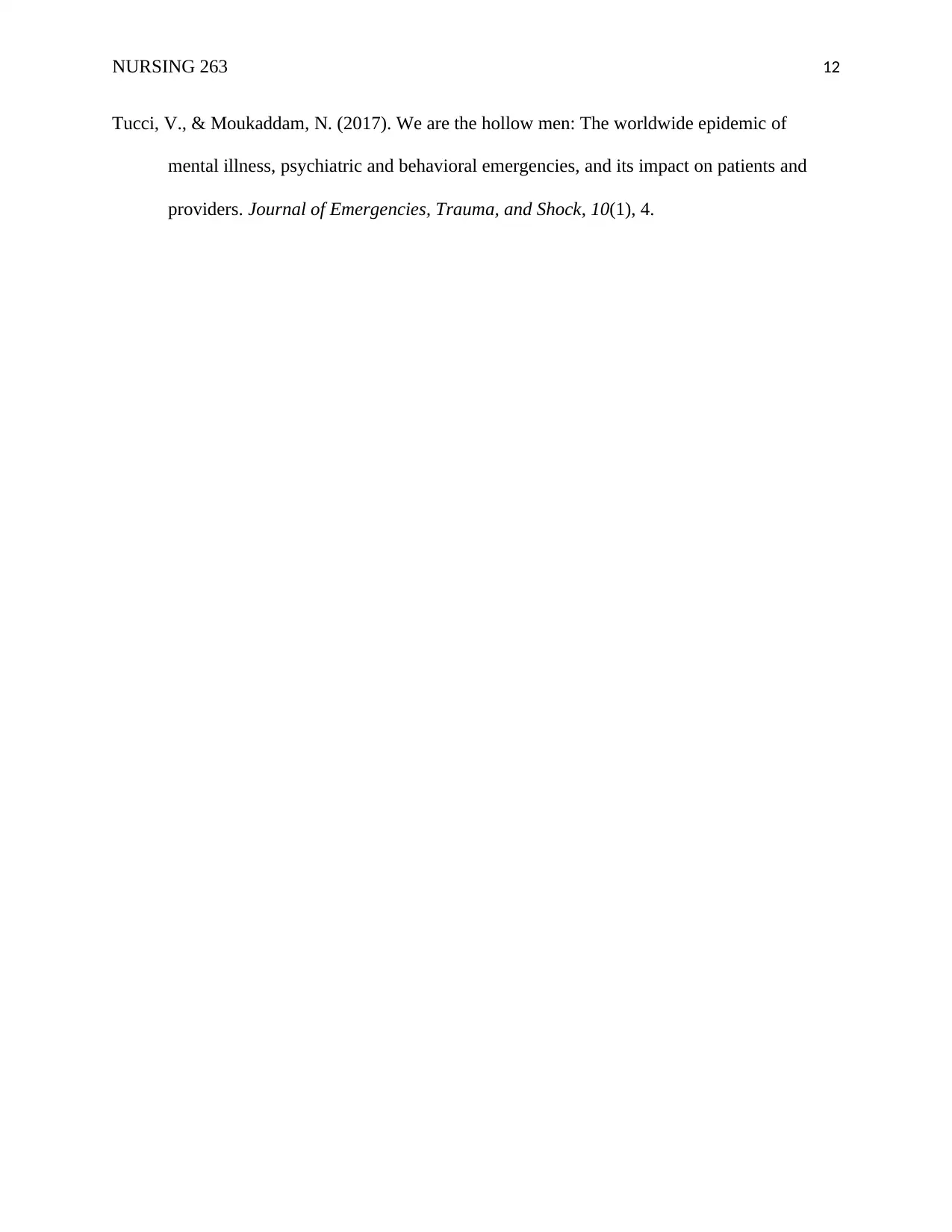
NURSING 263 12
Tucci, V., & Moukaddam, N. (2017). We are the hollow men: The worldwide epidemic of
mental illness, psychiatric and behavioral emergencies, and its impact on patients and
providers. Journal of Emergencies, Trauma, and Shock, 10(1), 4.
Tucci, V., & Moukaddam, N. (2017). We are the hollow men: The worldwide epidemic of
mental illness, psychiatric and behavioral emergencies, and its impact on patients and
providers. Journal of Emergencies, Trauma, and Shock, 10(1), 4.
1 out of 12
Related Documents
Your All-in-One AI-Powered Toolkit for Academic Success.
+13062052269
info@desklib.com
Available 24*7 on WhatsApp / Email
![[object Object]](/_next/static/media/star-bottom.7253800d.svg)
Unlock your academic potential
© 2024 | Zucol Services PVT LTD | All rights reserved.





